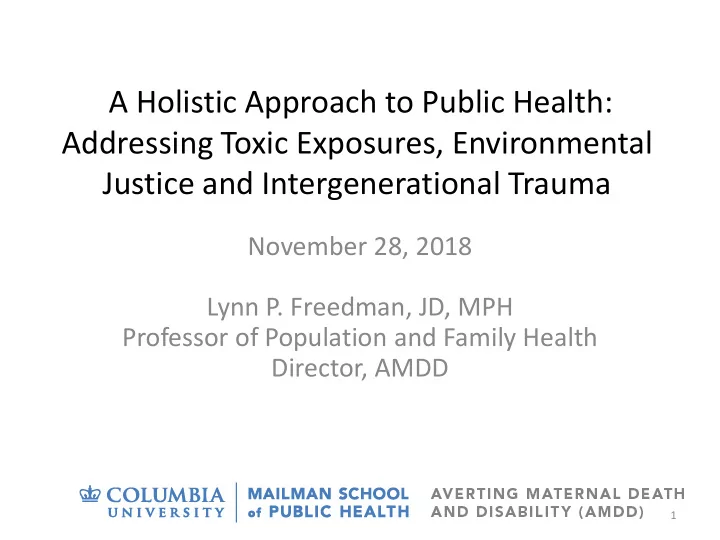

A Holistic Approach to Public Health: Addressing Toxic Exposures, Environmental Justice and Intergenerational Trauma November 28, 2018 Lynn P. Freedman, JD, MPH Professor of Population and Family Health Director, AMDD 1
Health is political • Access to and distribution of power and resources • Building a social and political movement for change 2
Health systems as core social institutions • Health systems are not just mechanical delivery systems for delivering clinical interventions. • They are part of the very fabric of social and civic life. • Like education system, justice system, police system . . . Health systems function as core social institution 3
Health System as Core Social Institution • Neglect, abuse and marginalization by the health system is part of the very experience of being poor • Effective health claims are assets of citizens in a democratic society 4
MMR in NYC and USA by race 5
6
AI/AN Maternal and infant mortality (UIHP service areas) UIHP Community Health Profile 2017 7
Warne and Lajimodiere (2015) 8
Xakmok Kasek Indigenous Community v. Paraguay • Inter-American Court o Human Rights (2010) • Challenging Paraguay’s failure to ensure the right of the Xakmok Kasek people to their ancestral property “[T]he Court has established that the spiritual and physical foundations of the identity of indigenous peoples are based, above all, on their unique relationship to their lands.” (112) The vulnerability created by the violations of right to property and cultural identity, were deemed by the court to be responsible for specific deaths, including that of Remigia Ruiz, who died in childbirth at age 38. 9
Reproductive Justice Beyond reproductive health (service delivery focus) Beyond reproductive rights (legal focus – individual choice) Broader analysis of structural conditions that affect reproductive lives including rights – to have children – not to have children – to parent children Reproductive oppression: the control and exploitation of women, girls and individuals through their bodies, sexuality, labor and reproduction 10
Reproductive Health…Rights…Justice… How Do They Compare? Framework Reproductive Health Reproductive Rights Reproductive Justice Description Service Delivery Model Legal/Advocacy-based Model Organizing Model Analysis Focuses on addressing the reproductive health needs Protects an individual’s right to access to Focuses on human rights and intersectionality as a of women. reproductive health services. way to organize communities to change structural inequalities. Constituents Patients in need of services and/or education. Individuals who are encouraged to actively Community members who are organized to lead participate in the political process. against reproductive oppression and other injustices. Key Players Providers : Those who work as, or are allied with, Advocates : Those who work as, o are allied with, Organizers: Those who work as, or are allied with medical professionals, community and public health advocates, legal experts, policymakers, and elected reproductive rights, reproductive health, and social educators, health researchers, and health service officials. justice and other justice organizations. providers. Strategy Improve and expand services; cultural competency; Advocacy at the state and federal level; focus on Support leadership and power in marginalized research and access. protecting enacted policies and defending existing communities; build social, political, economic power; rights. create societal change; connects with allied social justice movements. Limitations As services and education are offered on an Emphasizes individual choice without social context Challenges the “status quo” of power relations, individual level, the root causes of health disparities of choice. Assumes individuals have a level of assumptions, and societal views. Campaign- based are not addressed. knowledge about policy and access to elected organizing tends to be lengthy and resource- officials. intensive. Adapted by NYC DOHMH from Asian Communities for Reproductive Justice 2005 11
Recommend
More recommend